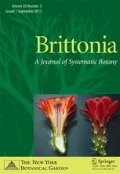Abstract
Karyotypes of 24 diploid (2n=12)Tragopogon species are similar with one long pair of chromosomes (A), two medium-length pairs (B and C), and three short pairs (D, E, and F). These species may be divided into three karyotypic groups: 1) seven species with a satellite on A and on D; 2) 14 species with a satellite on A only; and 3) three species with a satellite on D only. Most species within karyotype groups may be separated from each other either by distinctive features of certain chromosomes or by statistical differences in length of chromosome arms or long arm: short arm ratios of chromosome A. Three tetraploid (2n=24) species had two long pairs (A,A′), four medium-length pairs (B,B′;C,C′), and six short pairs (D,D′;E,E′;F,F′). Suggestions are made as to the putative diploid parents of these presumed allotetraploids.
Literature Cited
Belzer, N. F. & M. Ownbey. 1971. Chromatographic comparison ofTragopogon species and hybrids. Amer. J. Bot. 58: 791–802.
Carmer, S. G. & M. R. Swanson. 1971. Detection of differences between means: a Monte Carlo study of five pairwise multiple comparison procedures. Agron. J. 63: 940–945.
Chadvarov, L. P. & G. N. Georgiev. 1973. Karyological study ofTragopogon porrifolius L. Compt. Rend. Acad. Bulgar. Sci. 26: 957–960.
Feinbrun-Dothan, N. 1978.Tragopogon.In: Flora Palaestina 3: 421–423. Israel Acad. Sci. and Human. Jerusalem.
Matthews, V. A. 1975.Tragopogon. Pages 657–668.In: Flora of Turkey and the East Aegean Islands. Univ. of Edinburgh Press, Edinburgh Scotland.
Ownbey, M. 1950. Natural hybridization and amphiploidy in the genusTragopogon. Amer. J. Bot. 37: 487–499.
— & G. B. McCollum. 1953. Cytoplasmic inheritance and reciprocal amphiploidy inTragopogon. Amer. J. Bot. 40: 788–796.
——. 1954. The chromosomes ofTragopogon. Rhodora 56: 7–21.
Rechinger, K. H. 1977.Tragopogon. Pages 85–120, Tabs. 52–81. Fl. Iran. no. 122. Akademische Druck- u. Verlagsanstalt Graz, Austria.
Richardson, J. F. 1976.Tragopogon. Pages 322–325.In: Flora Europaea. Cambridge Univ. Press, Cambridge, England.
Stebbins, G. L., Jr. 1953. A new classification of the tribe Cichorieae, family Compositae. Madroño 12: 65–81.
Tomb, A. S., K. L. Chambers, D. W. Kyhos, A. M. Powell & P. H. Raven. 1978. Chromosome numbers in the Compositae. XIV. Lactuceae. Amer. J. Bot. 65: 717–722.
Wilson, F. D. 1982. A cytological basis for the separation ofGeropogon fromTragopogon (Compositae, Lactuceae). Brittonia 34: 290–293.
Winge, O. 1938. Inheritance of species characters inTragopogon. A cytogenetic investigation. Compt. Rend. Lab. Carlsberg, Ser. Physiol. 22: 155–195. Plates I & II.
Author information
Authors and Affiliations
Rights and permissions
About this article
Cite this article
Douglas Wilson, F. Karyotypes of tragopogon (Compositae: Lactuceae). Brittonia 35, 341–350 (1983). https://doi.org/10.2307/2805981
Issue Date:
DOI: https://doi.org/10.2307/2805981

